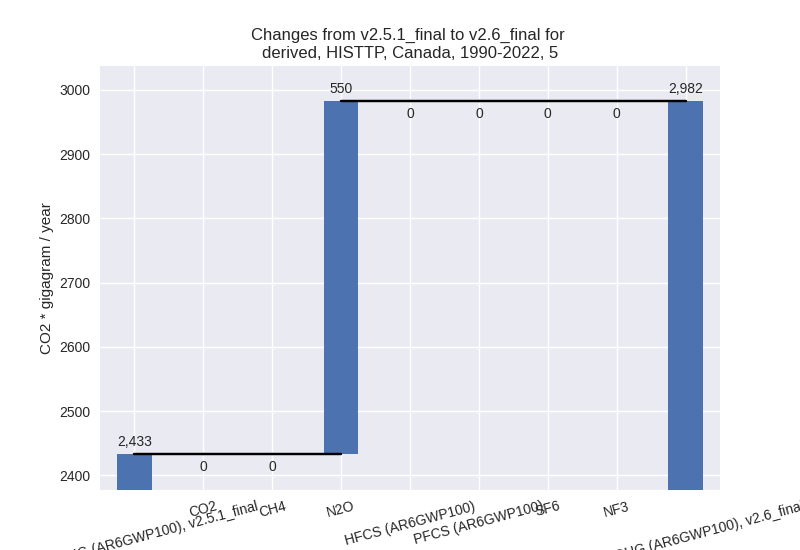Changes in PRIMAP-hist v2.6_final compared to v2.5.1_final for Canada
2024-09-24
Johannes Gütschow
Change analysis for Canada for PRIMAP-hist v2.6_final compared to v2.5.1_final
Overview over emissions by sector and gas
The following figures show the aggregate national total emissions excluding LULUCF AR6GWP100 for the country reported priority scenario. The dotted linesshow the v2.5.1_final data.
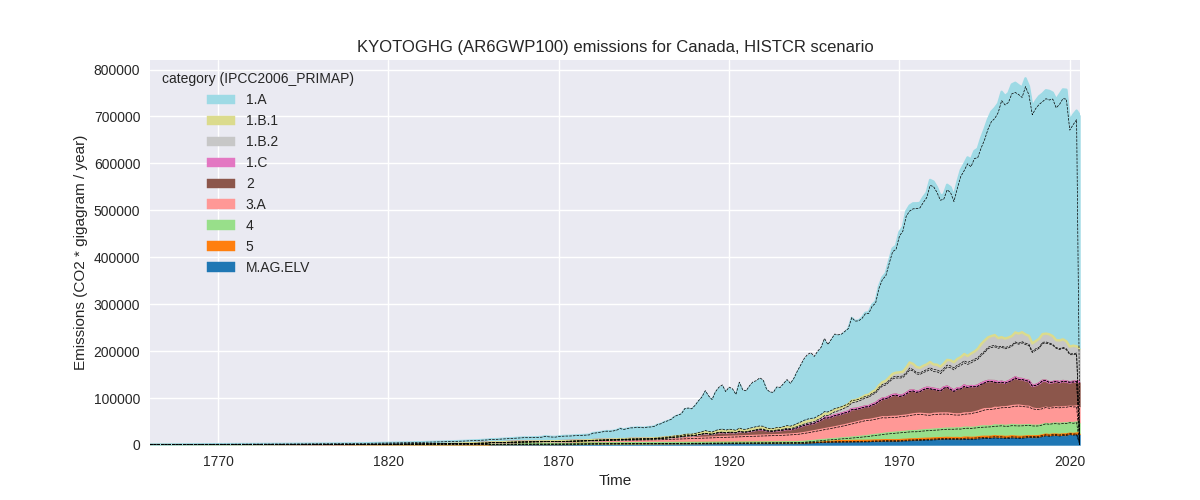
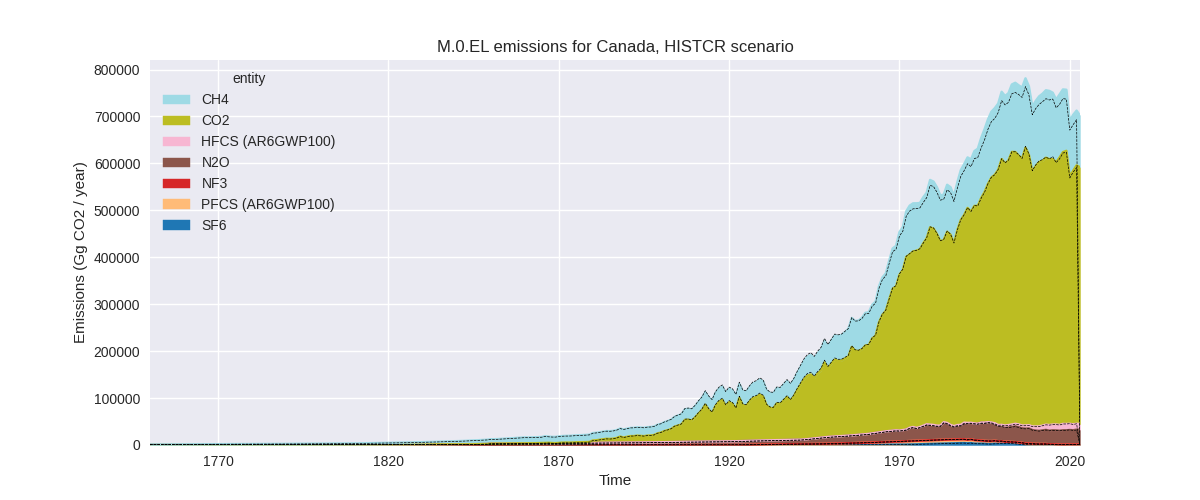

The following figures show the aggregate national total emissions excluding LULUCF AR6GWP100 for the third party priority scenario. The dotted linesshow the v2.5.1_final data.
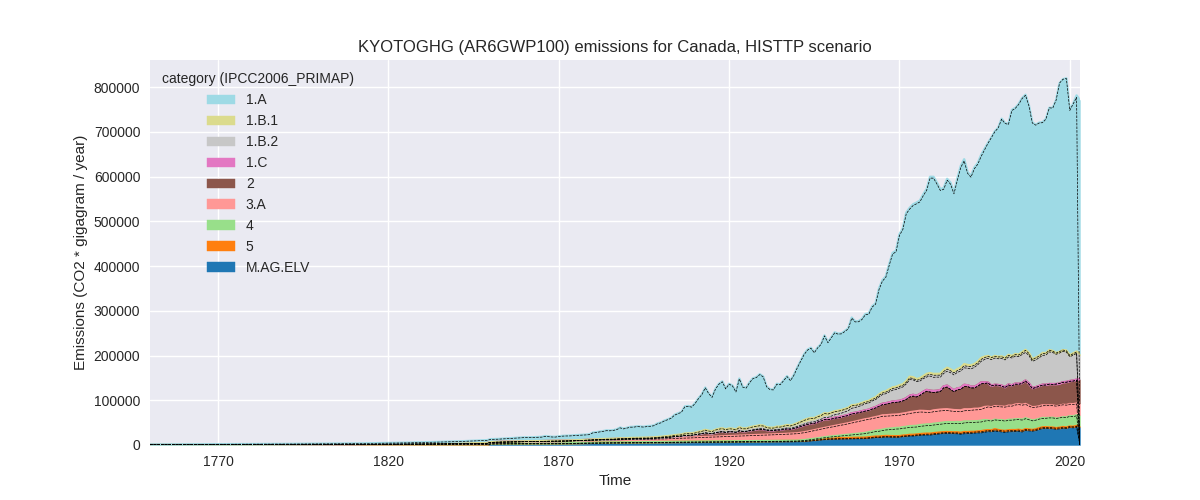
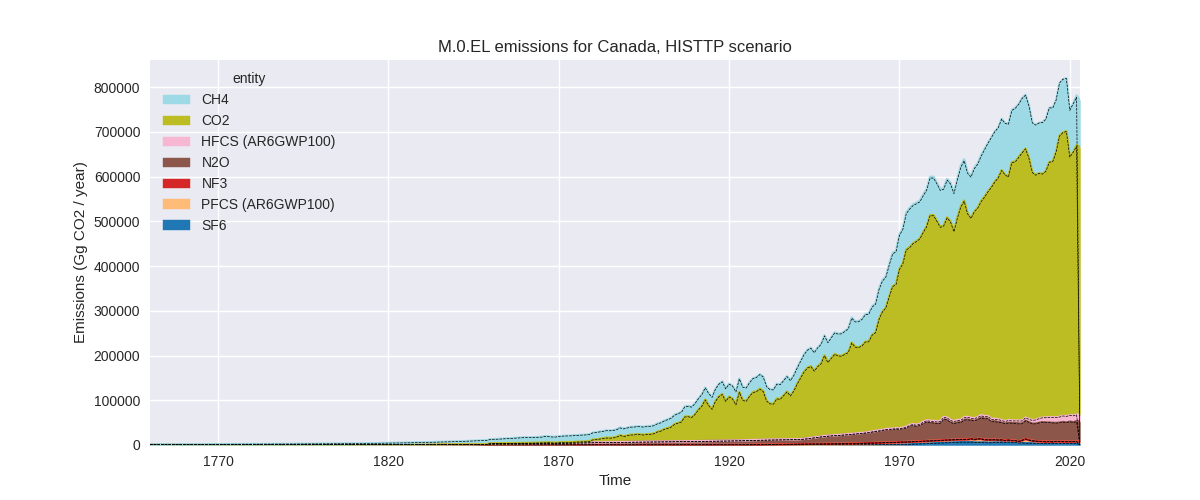
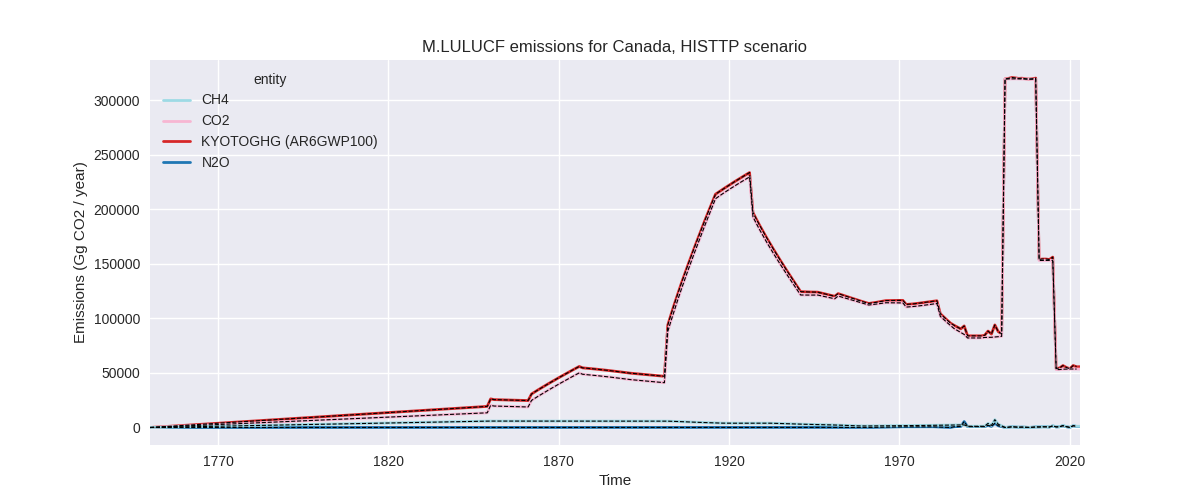
Overview over changes
In the country reported priority scenario we have the following changes for aggregate Kyoto GHG and national total emissions excluding LULUCF (M.0.EL):
- Emissions in 2022 have changed by 2.8%% (19284.55 Gg CO2 / year)
- Emissions in 1990-2022 have changed by 2.7%% (18835.71 Gg CO2 / year)
In the third party priority scenario we have the following changes for aggregate Kyoto GHG and national total emissions excluding LULUCF (M.0.EL):
- Emissions in 2022 have changed by 0.5%% (4154.94 Gg CO2 / year)
- Emissions in 1990-2022 have changed by 0.1%% (1059.78 Gg CO2 / year)
Most important changes per scenario and time frame
In the country reported priority scenario the following sector-gas combinations have the highest absolute impact on national total KyotoGHG (AR6GWP100) emissions in 2022 (top 5):
- 1: 1.B.2, CH4 with 13346.19 Gg CO2 / year (31.4%)
- 2: 1.A, CO2 with 4085.44 Gg CO2 / year (0.8%)
- 3: 1.B.2, CO2 with 1704.33 Gg CO2 / year (10.8%)
- 4: 2, HFCS (AR6GWP100) with -1023.20 Gg CO2 / year (-7.6%)
- 5: 1.B.1, CO2 with -753.08 Gg CO2 / year (-100.0%)
In the country reported priority scenario the following sector-gas combinations have the highest absolute impact on national total KyotoGHG (AR6GWP100) emissions in 1990-2022 (top 5):
- 1: 1.B.2, CH4 with 18443.09 Gg CO2 / year (34.0%)
- 2: 1.B.1, CO2 with -798.33 Gg CO2 / year (-100.0%)
- 3: 1.A, CH4 with 566.32 Gg CO2 / year (9.6%)
- 4: 5, N2O with 549.59 Gg CO2 / year (22.6%)
- 5: 1.B.2, CO2 with -167.30 Gg CO2 / year (-1.1%)
In the third party priority scenario the following sector-gas combinations have the highest absolute impact on national total KyotoGHG (AR6GWP100) emissions in 2022 (top 5):
- 1: 1.A, CO2 with 3283.89 Gg CO2 / year (0.6%)
- 2: 2, HFCS (AR6GWP100) with -501.82 Gg CO2 / year (-3.3%)
- 3: 4, CH4 with 345.48 Gg CO2 / year (1.6%)
- 4: 2, PFCS (AR6GWP100) with 305.82 Gg CO2 / year (8.1%)
- 5: 5, N2O with 275.32 Gg CO2 / year (13.8%)
In the third party priority scenario the following sector-gas combinations have the highest absolute impact on national total KyotoGHG (AR6GWP100) emissions in 1990-2022 (top 5):
- 1: 5, N2O with 549.59 Gg CO2 / year (22.6%)
- 2: 4, CH4 with 179.50 Gg CO2 / year (0.8%)
- 3: 4, N2O with 105.13 Gg CO2 / year (14.5%)
- 4: 1.A, CO2 with 65.44 Gg CO2 / year (0.0%)
- 5: 2, HFCS (AR6GWP100) with -15.21 Gg CO2 / year (-0.2%)
Notes on data changes
Here we list notes explaining important emissions changes for the country. ’' means that the following text only applies to the TP time series, while means that it only applies to the CR scenario. Otherwise the note applies to both scenarios.
- The 2024 inventory report has been included.
- The change in CH4 from 1.B.2 comes from strongly increased emissions factor for venting of CH4 in oil and gas production.
- Fugitive CO2 emissions from solid fuel production are included as 0 in the new inventory and are now 0 in the CR time-series.
- Higher CH4 emissions from fossil fuel combustion (1.A) are mostly due to higher CH4 emissions factors for gaseous fuels.
- Changes in HFCs come from replacing numerical trends with data from the 2024 inventory.
- In the TP scenario the main reason for 2022 changes are the f-gas trends.
Changes by sector and gas
For each scenario and time frame the changes are displayed for all individual sectors and all individual gases. In the sector plot we use aggregate Kyoto GHGs in AR6GWP100. In the gas plot we usenational total emissions without LULUCF. ## country reported scenario
2022
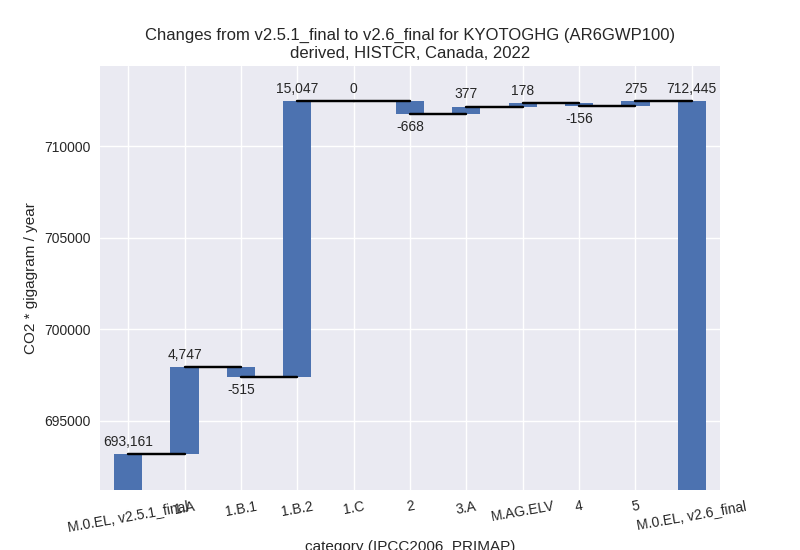
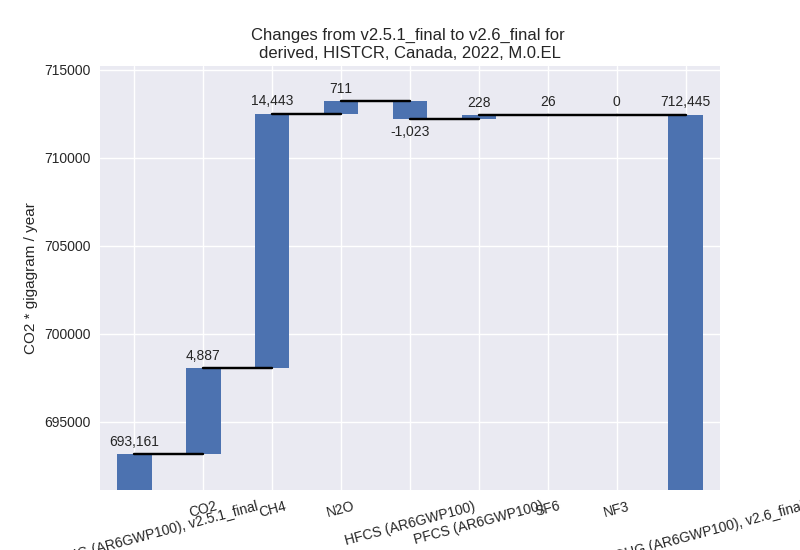
1990-2022
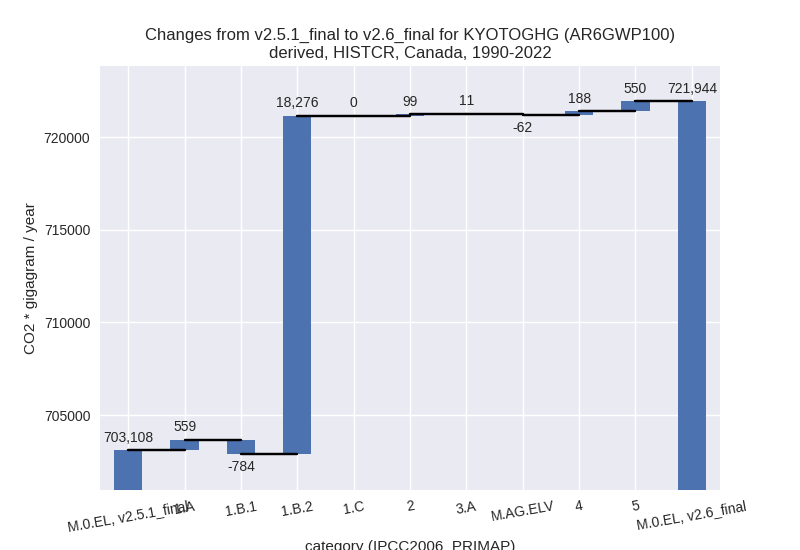
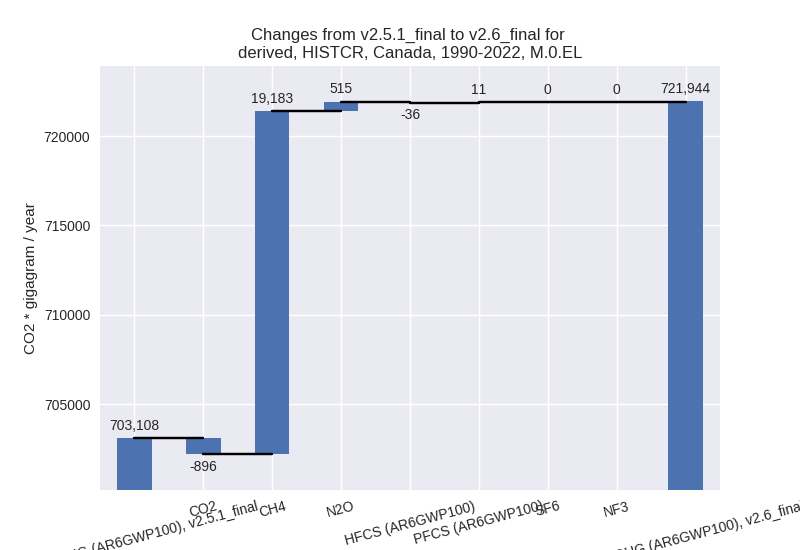
third party scenario
2022
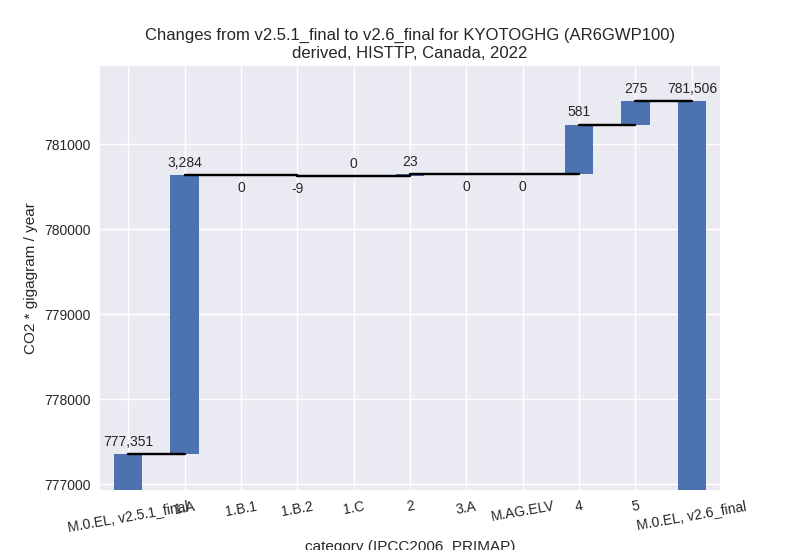
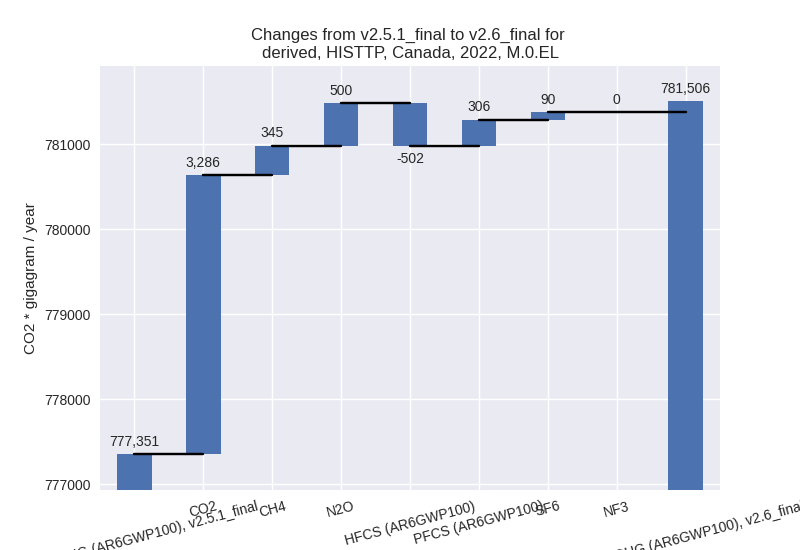
1990-2022
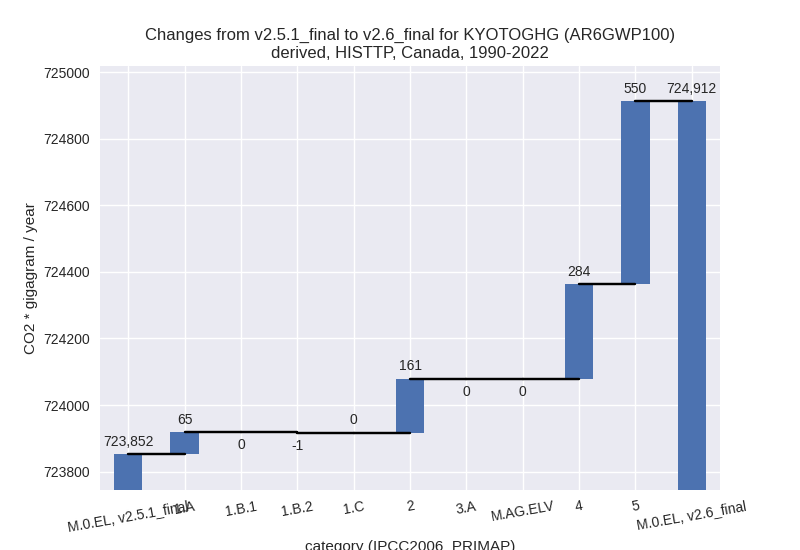

Detailed changes for the scenarios:
country reported scenario (HISTCR):
Most important changes per time frame
For 2022 the following sector-gas combinations have the highest absolute impact on national total KyotoGHG (AR6GWP100) emissions in 2022 (top 5):
- 1: 1.B.2, CH4 with 13346.19 Gg CO2 / year (31.4%)
- 2: 1.A, CO2 with 4085.44 Gg CO2 / year (0.8%)
- 3: 1.B.2, CO2 with 1704.33 Gg CO2 / year (10.8%)
- 4: 2, HFCS (AR6GWP100) with -1023.20 Gg CO2 / year (-7.6%)
- 5: 1.B.1, CO2 with -753.08 Gg CO2 / year (-100.0%)
For 1990-2022 the following sector-gas combinations have the highest absolute impact on national total KyotoGHG (AR6GWP100) emissions in 1990-2022 (top 5):
- 1: 1.B.2, CH4 with 18443.09 Gg CO2 / year (34.0%)
- 2: 1.B.1, CO2 with -798.33 Gg CO2 / year (-100.0%)
- 3: 1.A, CH4 with 566.32 Gg CO2 / year (9.6%)
- 4: 5, N2O with 549.59 Gg CO2 / year (22.6%)
- 5: 1.B.2, CO2 with -167.30 Gg CO2 / year (-1.1%)
Changes in the main sectors for aggregate KyotoGHG (AR6GWP100) are
- 1: Total sectoral emissions in 2022 are 577055.50
Gg CO2 / year which is 81.0% of M.0.EL emissions. 2022 Emissions have
changed by 3.5% (19279.36 Gg CO2 /
year). 1990-2022 Emissions have changed by 3.2% (18050.41 Gg CO2 / year). For 2022
the changes per gas
are:
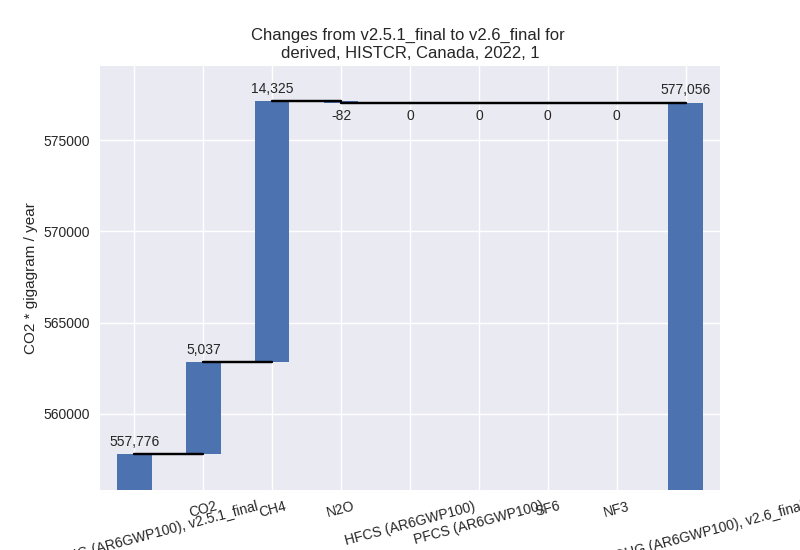
For 1990-2022 the changes per gas are: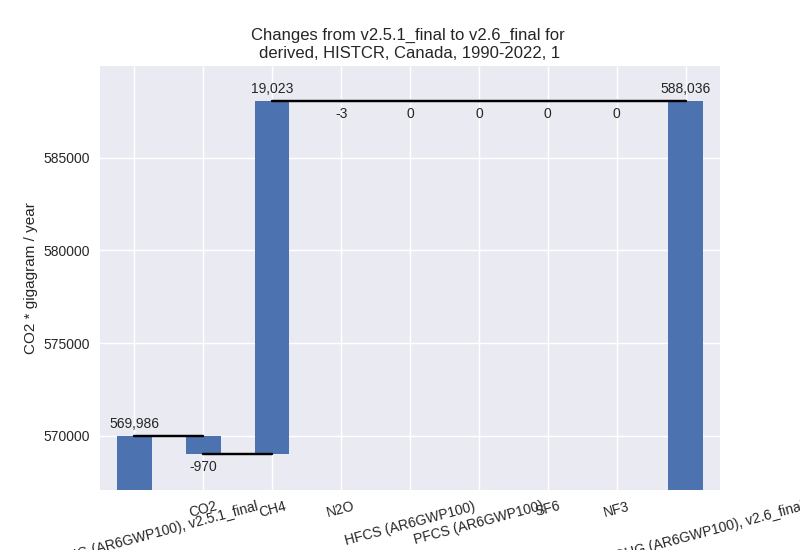
The changes come from the following subsectors:- 1.A: Total sectoral emissions in 2022 are 502083.09 Gg CO2 / year which is 87.0% of category 1 emissions. 2022 Emissions have changed by 1.0% (4747.09 Gg CO2 / year). 1990-2022 Emissions have changed by 0.1% (559.13 Gg CO2 / year).
- 1.B.1: Total sectoral emissions in 2022 are 1518.50
Gg CO2 / year which is 0.3% of category 1 emissions. 2022 Emissions have
changed by -25.3% (-515.20 Gg CO2 /
year). 1990-2022 Emissions have changed by -29.7% (-784.32 Gg CO2 / year). For 2022
the changes per gas
are:
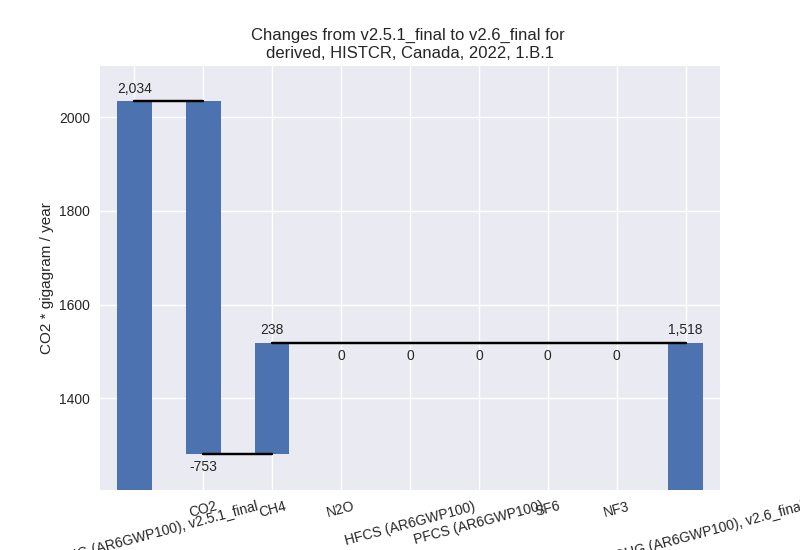
For 1990-2022 the changes per gas are: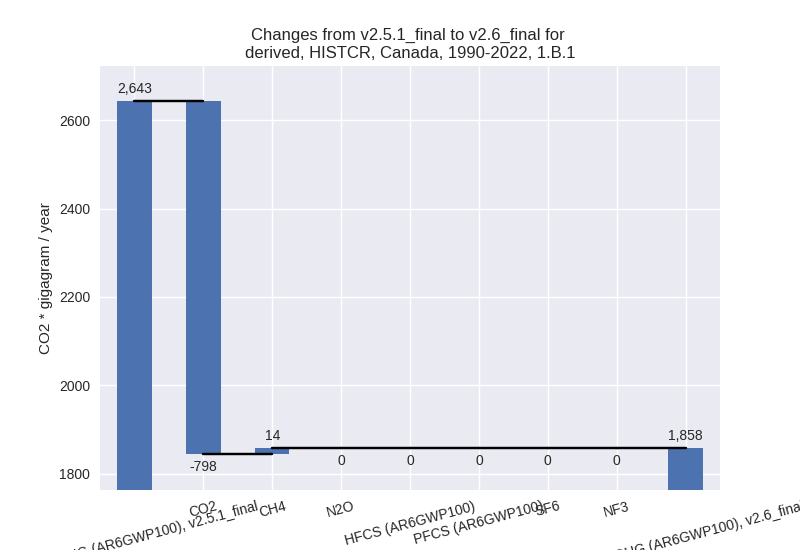
There is no subsector information available in PRIMAP-hist. - 1.B.2: Total sectoral emissions in 2022 are
73453.27 Gg CO2 / year which is 12.7% of category 1 emissions. 2022
Emissions have changed by 25.8%
(15047.29 Gg CO2 / year). 1990-2022 Emissions have changed by 26.2% (18275.59 Gg CO2 / year). For 2022
the changes per gas
are:
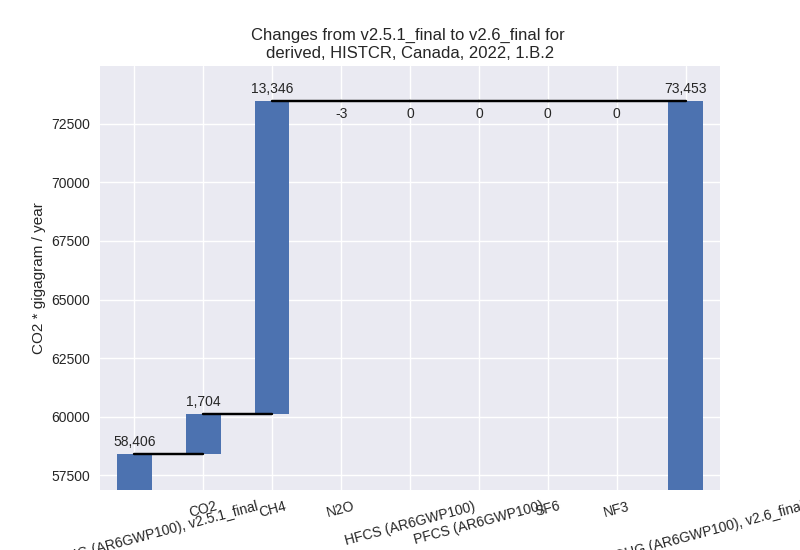
For 1990-2022 the changes per gas are: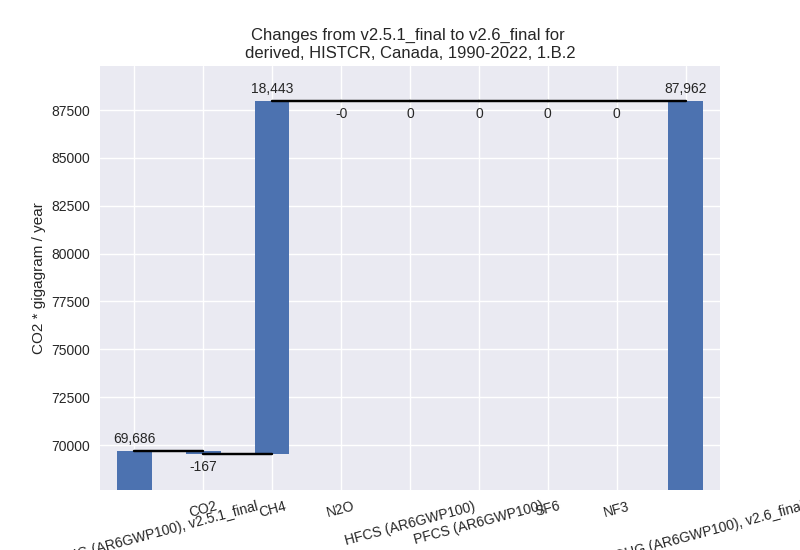
There is no subsector information available in PRIMAP-hist. - 1.C: Total sectoral emissions in 2022 are 0.64 Gg
CO2 / year which is 0.0% of category 1 emissions. 2022 Emissions have
changed by 36.6% (0.17 Gg CO2 /
year). 1990-2022 Emissions have changed by 4.1% (0.01 Gg CO2 / year). For 2022 the
changes per gas
are:
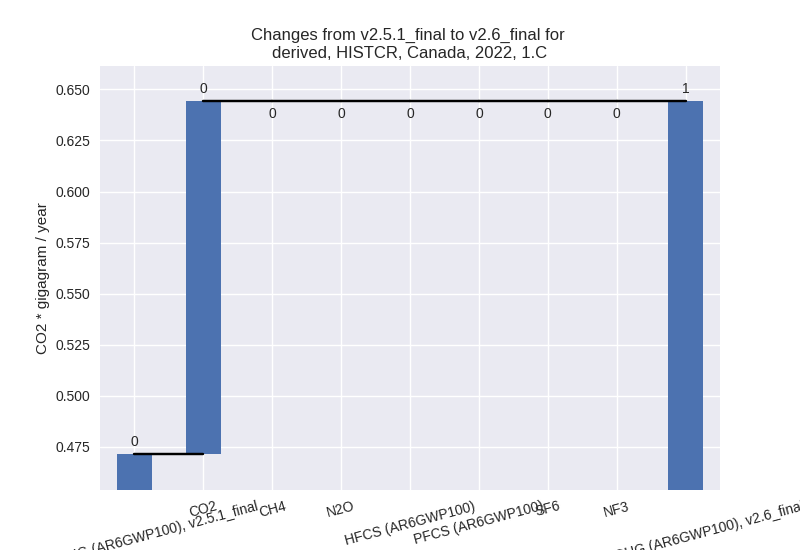
For 1990-2022 the changes per gas are: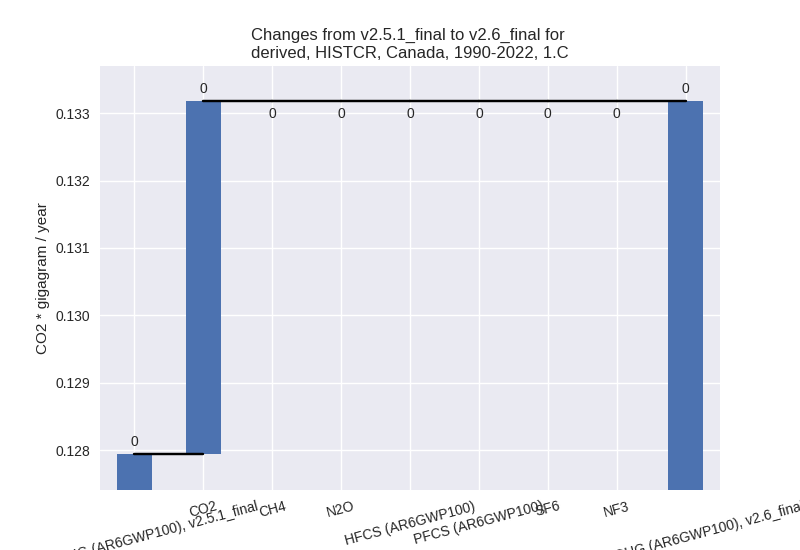
There is no subsector information available in PRIMAP-hist.
- 2: Total sectoral emissions in 2022 are 53302.61 Gg CO2 / year which is 7.5% of M.0.EL emissions. 2022 Emissions have changed by -1.2% (-667.86 Gg CO2 / year). 1990-2022 Emissions have changed by 0.2% (98.75 Gg CO2 / year).
- M.AG: Total sectoral emissions in 2022 are 56487.71 Gg CO2 / year which is 7.9% of M.0.EL emissions. 2022 Emissions have changed by 1.0% (554.14 Gg CO2 / year). 1990-2022 Emissions have changed by -0.1% (-50.61 Gg CO2 / year).
- 4: Total sectoral emissions in 2022 are 23328.97 Gg CO2 / year which is 3.3% of M.0.EL emissions. 2022 Emissions have changed by -0.7% (-156.41 Gg CO2 / year). 1990-2022 Emissions have changed by 0.8% (187.57 Gg CO2 / year).
- 5: Total sectoral emissions in 2022 are 2270.66 Gg
CO2 / year which is 0.3% of M.0.EL emissions. 2022 Emissions have
changed by 13.8% (275.32 Gg CO2 /
year). 1990-2022 Emissions have changed by 22.6% (549.59 Gg CO2 / year). For 2022 the
changes per gas
are:
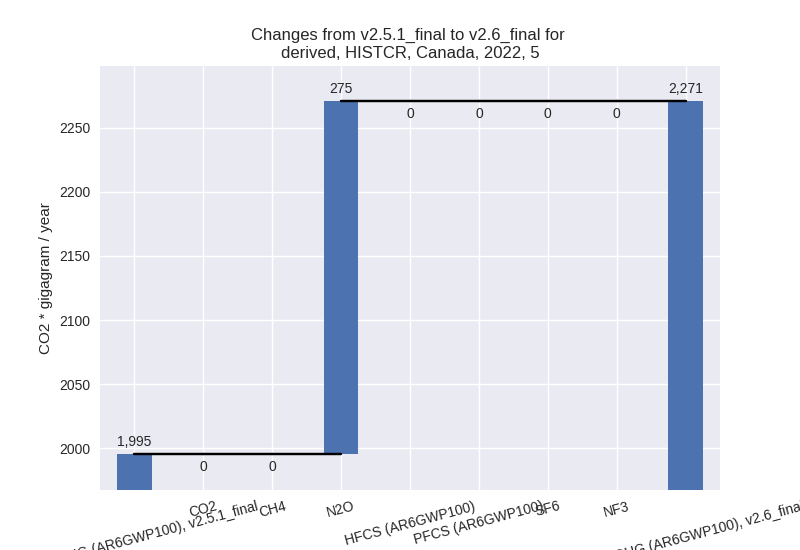
For 1990-2022 the changes per gas are: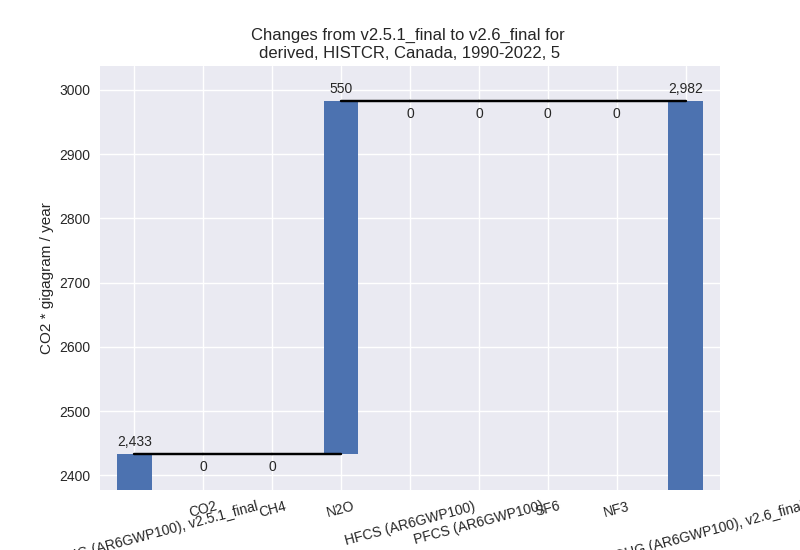
third party scenario (HISTTP):
Most important changes per time frame
For 2022 the following sector-gas combinations have the highest absolute impact on national total KyotoGHG (AR6GWP100) emissions in 2022 (top 5):
- 1: 1.A, CO2 with 3283.89 Gg CO2 / year (0.6%)
- 2: 2, HFCS (AR6GWP100) with -501.82 Gg CO2 / year (-3.3%)
- 3: 4, CH4 with 345.48 Gg CO2 / year (1.6%)
- 4: 2, PFCS (AR6GWP100) with 305.82 Gg CO2 / year (8.1%)
- 5: 5, N2O with 275.32 Gg CO2 / year (13.8%)
For 1990-2022 the following sector-gas combinations have the highest absolute impact on national total KyotoGHG (AR6GWP100) emissions in 1990-2022 (top 5):
- 1: 5, N2O with 549.59 Gg CO2 / year (22.6%)
- 2: 4, CH4 with 179.50 Gg CO2 / year (0.8%)
- 3: 4, N2O with 105.13 Gg CO2 / year (14.5%)
- 4: 1.A, CO2 with 65.44 Gg CO2 / year (0.0%)
- 5: 2, HFCS (AR6GWP100) with -15.21 Gg CO2 / year (-0.2%)
Changes in the main sectors for aggregate KyotoGHG (AR6GWP100) are
- 1: Total sectoral emissions in 2022 are 635607.44 Gg CO2 / year which is 81.3% of M.0.EL emissions. 2022 Emissions have changed by 0.5% (3275.40 Gg CO2 / year). 1990-2022 Emissions have changed by 0.0% (64.90 Gg CO2 / year).
- 2: Total sectoral emissions in 2022 are 53267.42 Gg CO2 / year which is 6.8% of M.0.EL emissions. 2022 Emissions have changed by 0.0% (23.24 Gg CO2 / year). 1990-2022 Emissions have changed by 0.3% (161.28 Gg CO2 / year).
- M.AG: Total sectoral emissions in 2022 are 66732.55 Gg CO2 / year which is 8.5% of M.0.EL emissions. 2022 Emissions have changed by 0.0% (0.00 Gg CO2 / year). 1990-2022 Emissions have changed by 0.0% (0.00 Gg CO2 / year).
- 4: Total sectoral emissions in 2022 are 23628.30 Gg
CO2 / year which is 3.0% of M.0.EL emissions. 2022 Emissions have
changed by 2.5% (580.98 Gg CO2 /
year). 1990-2022 Emissions have changed by 1.3% (284.01 Gg CO2 / year). For 2022 the
changes per gas
are:

- 5: Total sectoral emissions in 2022 are 2270.66 Gg
CO2 / year which is 0.3% of M.0.EL emissions. 2022 Emissions have
changed by 13.8% (275.32 Gg CO2 /
year). 1990-2022 Emissions have changed by 22.6% (549.59 Gg CO2 / year). For 2022 the
changes per gas
are:
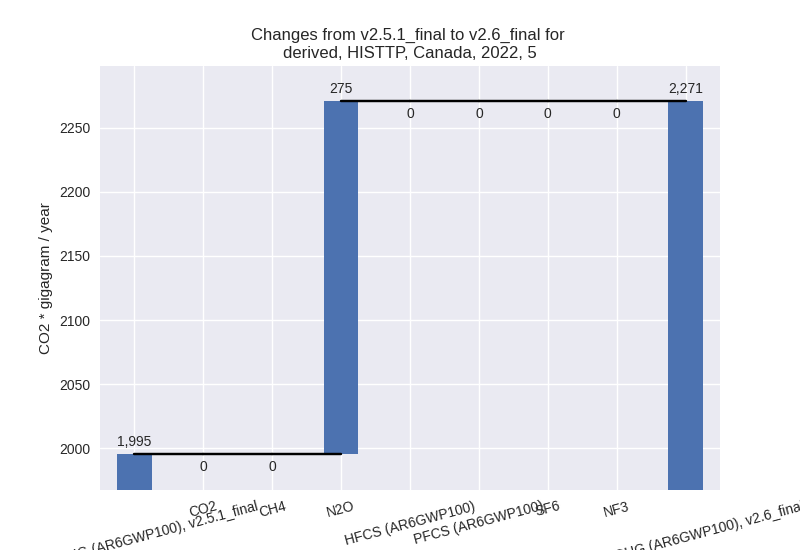
For 1990-2022 the changes per gas are: